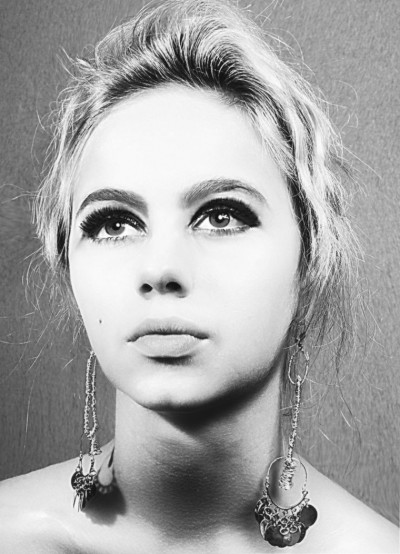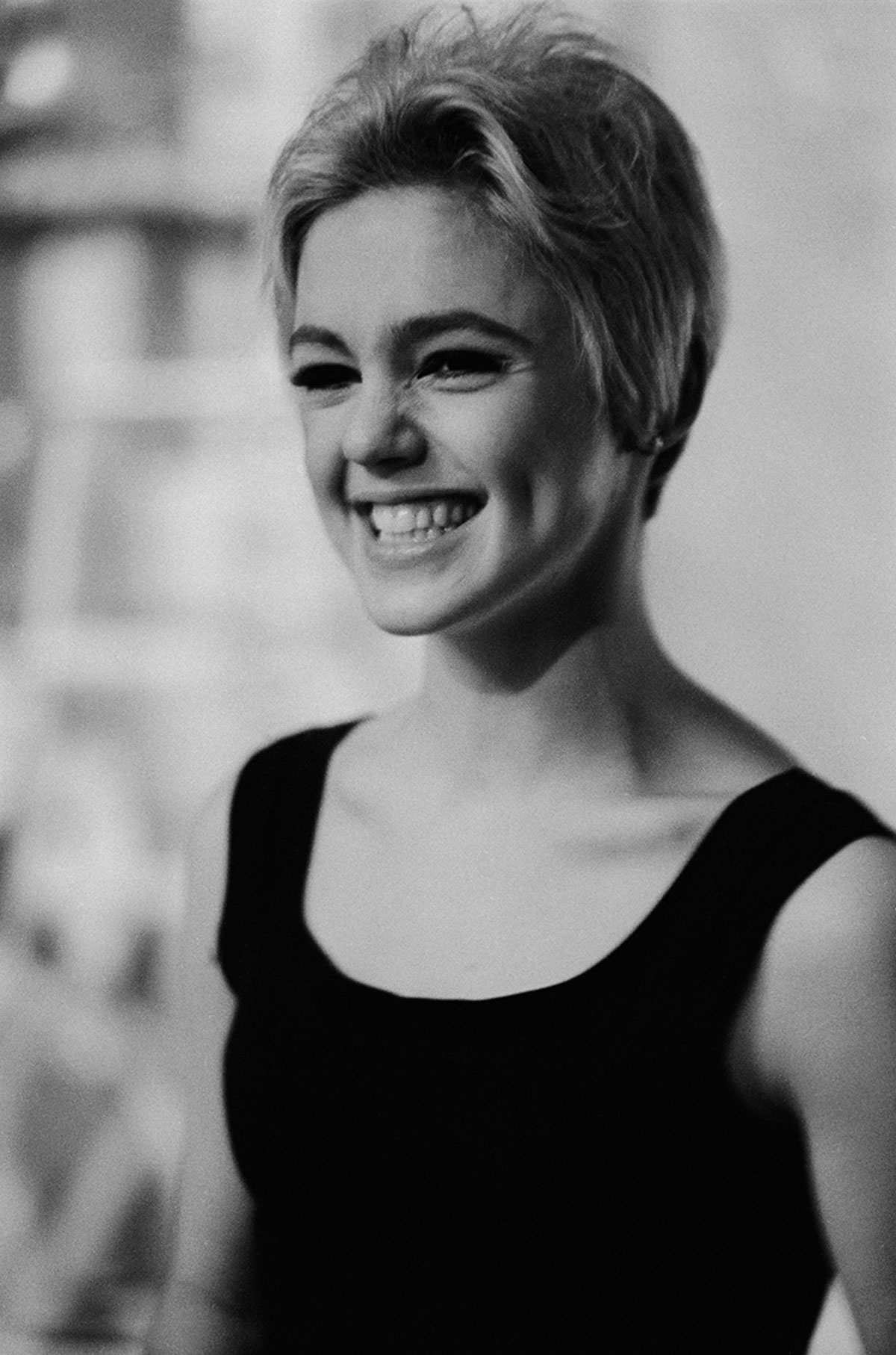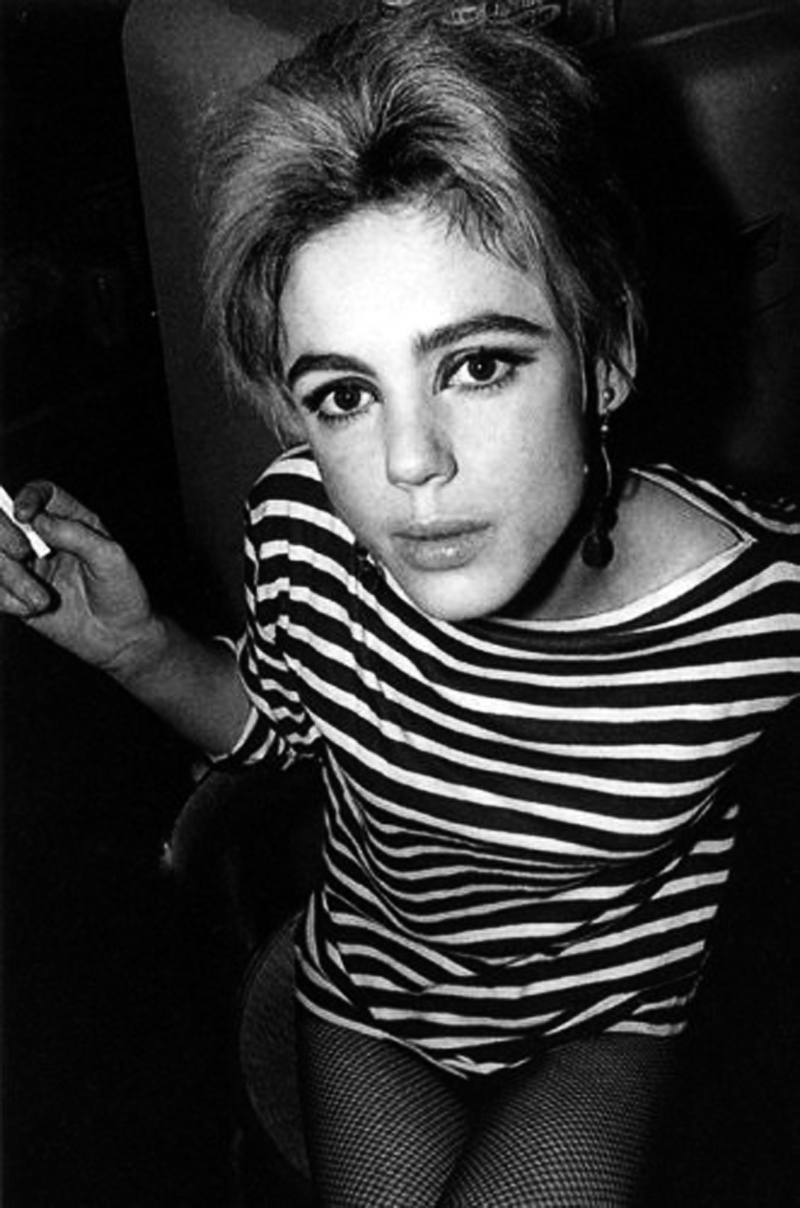Edie Sedgwick (Edie Minturn Sedgwick)

Sedgwick’s family was long established in Massachusetts history. Her seventh-great grandfather, English-born Robert Sedgwick, was the first Major General of the Massachusetts Bay Colony settling in Charlestown, Massachusetts in 1635. Sedgwick’s family later originated from Stockbridge, Massachusetts where her great-great-great grandfather Judge Theodore Sedgwick had settled after the American Revolution. Theodore married Pamela Dwight of the New England Dwight family who was the daughter of Abigail (née Williams) Dwight. Ephraim Williams, the founder of Williams College, was Sedgwick’s fifth-great grandfather. Judge Theodore Sedgwick was the first to plead and win a case for the freedom of a black woman, Elizabeth Freeman, under the Massachusetts Bill of Rights that declared all men to be born free and equal. Her great-great-great paternal grandfather, William Ellery, was a signatory of the United States Declaration of Independence.
Sedgwick’s mother Alice was the daughter of Henry Wheeler de Forest, the President and Chairman of the Board of the Southern Pacific Railroad and a direct descendant of Jessé de Forest whose Dutch West India Company helped to settle New Amsterdam. Jessé de Forest was also Edie’s seventh-great grandfather. Her paternal grandfather was the historian and acclaimed author Henry Dwight Sedgwick III; her great grandmother, Susanna Shaw, was the sister of Robert Gould Shaw, the American Civil War Colonel; and her great-great grandfather, Robert Bowne Minturn, was a part owner of the Flying Cloud clipper ship and is credited with creating and promoting Central Park in New York City. She was the first cousin, once removed, of actress Kyra Sedgwick. Kyra is the daughter of Henry Dwight Sedgwick V (Edie’s first cousin), the son of Robert Minturn Sedgwick, who was the older brother of Francis Minturn Sedgwick.
Edie Sedgwick was the seventh of eight children born in Santa Barbara, California, to Alice Delano de Forest (1908–1988) and Francis Minturn Sedgwick (1904–1967), a philanthropist, rancher and sculptor. She was named after her father’s aunt, Edith Minturn, who was famously painted with her husband, Isaac Newton Phelps-Stokes, by John Singer Sargent. Despite Sedgwick’s family’s wealth and high social status, her early life was troubled. All the Sedgwick children had deeply conflicted relationships with their father (whom the children called “Fuzzy”). The children adored Fuzzy but by most accounts he was narcissistic, emotionally remote, controlling and frequently abusive. Sedgwick also had a very difficult relationship with her father, who openly carried on affairs with other women. On one occasion, she walked in on him while he was having sex with one of his mistresses. She flew into a rage, but Fuzzy claimed that Sedgwick imagined the whole event. As a result of her emotional problems, Sedgwick developed anorexia by her early teens and settled into a lifelong pattern of binging and purging.
The Sedgwick children were raised on their family’s California ranches. Initially schooled at home and cared for by nannies, their lives were rigidly controlled by their parents; they were largely isolated from the outside world and it was instilled into them that they were superior to most of their peers. At age 13, (the year her grandfather Henry Sedgwick died) Sedgwick began boarding at the Branson School near San Francisco. According to her older sister Alice “Saucie” Segwick, she was soon taken out of the school because of her anorexia. In 1958, she was enrolled at St. Timothy’s School in Maryland. She was eventually taken out of the school due to her anorexia. In the fall of 1962, at her father’s insistence, Sedgwick was committed to the private psychiatric hospital Silver Hill Hospital in New Canaan, Connecticut. As the regime was very lax, Sedgwick easily manipulated the situation at Silver Hill and her weight kept dropping. She was later sent to Bloomingdale, the Westchester County, New York division of the New York Hospital where her anorexia improved markedly. Around the time she left the hospital she had a brief relationship with a Harvard student, became pregnant and procured an abortion with her mother’s help.
In the fall of 1963, Sedgwick moved to Cambridge, Massachusetts and began studying sculpture with her cousin, artist Lily Saarinen. Saarinen said of her cousin Sedgwick, “She was very insecure about men, though all the men loved her.” During this period she partied with members of an elite bohemian fringe of the Harvard social scene, which included many gay men. Sedgwick was deeply affected by the loss of her older brothers, Francis, Jr. (known as “Minty”) and Robert (known as “Bobby”), who died within 18 months of each other. Francis Sedgwick, who had a particularly unhappy relationship with Fuzzy, suffered several breakdowns, eventually committing suicide in 1964 while committed at Silver Hill Hospital. Her second oldest brother Robert Sedgwick, who also suffered from mental health problems, died when his motorcycle crashed into the side of a New York City bus on New Year’s Eve 1965. It was ruled an accident but Edie told friends that she considered this a suicide as well.
Shortly before the death of her eldest brother Francis in 1964, Sedgwick moved to New York City to pursue a career in modeling. Around this time, she began taking drugs and was reportedly[citation needed] introduced to LSD by friends from Cambridge who knew Timothy Leary and Richard Alpert (two prominent Harvard professors who advocated LSD use for its alleged therapeutic and spiritual value). In March 1965, Sedgwick met artist and avant-garde filmmaker Andy Warhol at a dinner party held at Lester Persky’s apartment. Warhol was immediately impressed with Sedgwick’s background and her beauty and invited her and her friend Chuck Wein to visit him at his art studio dubbed The Factory. During one of those visits, Warhol was filming Vinyl, his interpretation of the novel A Clockwork Orange. Despite Vinyl ’s all-male cast, Warhol put Sedgwick in the movie. She also made a small cameo appearance in another Warhol film, Horse, when she entered towards the end of the film. Although Sedgwick’s appearances in both films were brief, they generated so much interest that Warhol decided to create a vehicle in which she could star.
The first of those films, Poor Little Rich Girl, was originally conceived as part of a series of films featuring Sedgwick called The Poor Little Rich Girl Saga. The series was to include Poor Little Rich Girl, Restaurant, Face and Afternoon. Filming of Poor Little Rich Girl began in March 1965 in Sedgwick’s apartment. Like the majority of Warhol’s avante garde films, Poor Little Rich Girl saw a limited release to underground film theaters and viewings at The Factory. Sedgwick’s next film for Warhol was Kitchen (1965). Written by Factory scriptwriter Ronald Tavel, the film stars Sedgwick, Rene Ricard, Roger Trudeau, Donald Lyons and Elecktrah. After Kitchen, Chuck Wein replaced Ronald Tavel as writer and assistant director for the filming of Beauty No. 2, in which Sedgwick appeared with Gino Piserchio.
Warhol’s films were not commercially successful and rarely seen outside The Factory circle and underground film theaters, but Sedgwick’s notoriety grew. Mainstream media outlets began reporting on her appearances in Warhol’s films and her unusual fashion sense. During this period, she developed her “trademark” look – black leotards, mini dresses, and large chandelier earrings. Sedgwick also cut her naturally brown hair short and colored it with silver spray, creating a similar look to the wigs Warhol wore. Warhol christened her his “Superstar” and both were photographed together at various social outings. Throughout 1965, Sedgwick and Warhol continued making films together – Outer and Inner Space, Prison, Lupe and Chelsea Girls. However, by late 1965, Sedgwick and Warhol’s relationship had deteriorated and Sedgwick requested that Warhol no longer show any of her films. The edited footage of Sedgwick in Chelsea Girls would eventually become the film Afternoon. Lupe is often thought to be Sedgwick’s last Warhol film, but Sedgwick filmed The Andy Warhol Story with Rene Ricard in November 1966, almost a year after she filmed Lupe. The Andy Warhol Story was an unreleased film that was only screened once at The Factory. The film featured Sedgwick, along with Ricard, satirically pretending to be Andy Warhol.
Following her estrangement from Warhol’s inner circle, Sedgwick began living at the Chelsea Hotel, where she became close to Bob Dylan. Dylan and his friends eventually convinced Sedgwick to sign up with Albert Grossman, Dylan’s manager. According to Paul Morrissey, Sedgwick had developed a crush on Dylan that she thought he reciprocated and were beginning a romantic relationship. She was also under the impression that she and Dylan would star in a mainstream film together. Unbeknownst to Sedgwick, Dylan had secretly married his girlfriend Sara Lownds in November 1965. Morrissey claimed that Sedgwick was informed of the marriage by Warhol (who reportedly heard about it through his lawyer) in February 1966. Friends of Sedgwick’s later said that she saw the supposed offer of doing a film with Dylan as a ticket to a mainstream film career. Paul Morrissey claimed that Dylan likely never had plans to star in a film with Sedgwick, and Dylan “…hadn’t been truthful.”
Since Sedgwick’s death, Bob Dylan has routinely denied that he ever had a romantic relationship with Sedgwick but did admit to knowing her. In December 2006, several weeks before the one-week release of the controversial Factory Girl, the Weinstein Company and the film’s producers interviewed Sedgwick’s older brother, Jonathan, who said that Sedgwick told him she had aborted a baby she claimed was Dylan’s. Jonathan Sedgwick claimed that Edie had the abortion soon after she was injured in a motorcycle accident. As a result of the accident, doctors consigned her to a mental hospital where she was treated for drug addiction.” No hospital records or Sedgwick family records exist to support this story. Nonetheless, Sedgwick’s brother also claimed “Staff found she was pregnant but, fearing the baby had been damaged by her drug use and anorexia, forced her to have the abortion.” Throughout most of 1966, Sedgwick was involved in an intense but troubled relationship with Dylan’s friend, Bob Neuwirth. During this time, she became increasingly dependent on barbiturates. In early 1967, unable to cope with Sedgwick’s drug abuse and erratic behavior, Neuwirth broke off their relationship.
After breaking with Andy Warhol and The Factory scene, Sedgwick attempted to forge a legitimate acting career. She auditioned for Norman Mailer. His stage adaptation of his novel The Deer Park was being produced. But Mailer “turned her down….—She was very good in a sort of tortured and wholly sensitive way—…She used so much of herself with every line that we knew she’d be immolated after three performances.” In March 1967, Sedgwick began shooting Ciao! Manhattan, a semi-autobiographical underground film co-directed by John Palmer and David Weisman. During this period she accidentally set her room on fire in the Chelsea Hotel, and was briefly hospitalized with burns. Due to Sedgwick’s rapidly deteriorating health from drug use, filming was suspended. After further hospitalizations for drug abuse and mental issues in 1968 and 1969, Sedgwick returned to her family’s ranch in California to recuperate. In August 1969, she was hospitalized again in the psychiatric ward of Cottage Hospital after being arrested for drug offenses by the local police. While in the hospital, Sedgwick met another patient, Michael Brett Post, whom she would marry in July 1971. Sedgwick was hospitalized yet again in the summer of 1970, but was let out under the supervision of a psychiatrist, two nurses, and the live-in care of filmmaker John Palmer and his wife Janet. Staunchly determined to finish Ciao! Manhattan and have her story told, Sedgwick reconnected with Ciao! Manhattan filmmakers and began shooting in Arcadia, California and Santa Barbara in late 1970. She also recorded audio tapes reflecting upon her life story which enabled Weisman and Palmer to incorporate her accounts into the film’s dramatic arc. Filming completed in early 1971. The film would not be released until February 1972.
Sedgwick married Michael Post on July 24, 1971, a fellow patient whom she met while committed to the Cottage Hospital in the summer of 1970. Under Post’s influence, she reportedly stopped abusing alcohol and other drugs for a short time. Her sobriety lasted until October 1971, when she was prescribed pain medication to treat a physical illness. Sedgwick soon began abusing barbiturates and alcohol. On the night of November 15, 1971, Sedgwick went to a fashion show at the Santa Barbara Museum, a segment of which was filmed for the television show An American Family. After the fashion show, she attended a party where she drank alcohol. She then phoned her husband to pick her up. On the way home, Sedgwick expressed thoughts of uncertainty about their marriage. Before they both fell asleep, Post gave Sedgwick the medication that had been prescribed for her. According to Post, Sedgwick started to fall asleep very quickly and her breathing was, “bad – it sounded like there was a big hole in her lungs”, but he attributed that to her heavy smoking habit and went to sleep. When Post awoke the following morning at 7.30 am, Sedgwick was dead. The coroner ruled her death as “undetermined/accident/suicide”. Her death certificate states the immediate cause was “probable acute barbiturate intoxication” due to ethanol intoxication. Sedgwick’s alcohol level was registered at 0.17% and her barbiturate level was 0.48 mg%. She was 28. Sedgwick was not buried in the Sedgwick Pie but in the small Oak Hill Cemetery in Ballard, California. Her epitaph reads “Edith Sedgwick Post – Wife Of Michael Brett Post 1943–1971”. Her mother Alice was buried next to her in 1988.
Born
- April, 20, 1943
- USA
- Santa Barbara, California
Died
- November, 16, 1971
- USA
- Santa Barbara, California
Cause of Death
- probable acute barbiturate intoxication
Cemetery
- Oak Hill Cemetery
- Ballard, California
- USA




